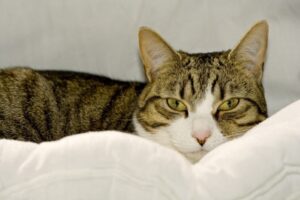How Often Do Once Blocked Cats Block Again
 By Kate O'Hara, DVM
By Kate O'Hara, DVM
angell.org/generalmedicine
generalmedicine@angell.org
617-522-7282
Urethral Obstruction (UO) is a life-threatening blockage of the lower portion of the urinary tract. Information technology prevents an animal from being able to urinate and, unfortunately, occurs relatively unremarkably in cats. Although UO can occur in any cat, it is more than prevalent in immature to centre age male cats. Male cats are more than vulnerable to UO in part because their urethra (the portion of the urinary tract connecting the bladder to the outside globe) is longer and narrower than in females. Overweight cats, and cats that consume dry food only may also exist at somewhat college risk.
Urethral obstruction can have a number of different causes. These include physical obstructions such equally urethral plugs, urinary stones, strictures, or tumors. Mechanical blockages tin likewise occur secondary to urethral spasm or swelling secondary to inflammation in the lower urinary tract. One common status in cats that can pb to inflammation in the float and secondary obstruction is Idiopathic Feline Lower Urinary Tract Disease, or Feline Idiopathic Cystitis.

A complete urethral obstruction causes a "back-upwards" of urine which can harm the lower urinary tract and crusade kidney failure. This leads to an accumulation of toxins in the bloodstream and electrolyte imbalances that can be life-threatening. Without assistance, UO can pb a cat to become critically ill within a short period of fourth dimension, so it is important for owners to recognize this condition early.
Unfortunately, signs of urethral obstruction may not be recognizable to many pet owners until the condition is quite advanced and the cat is quite obviously ill. Early signs of a developing UO include increased vocalization and frequent trips to the litter box. Owners may as well see cats licking more at their hind ends or straining unproductively in the litterbox. These signs are not specific to UO and may be misinterpreted by owners who think their cat may take a less emergent condition such every bit a urinary tract infection, cystitis, or even constipation which tin look similar. This misinterpretation may cause owners to think that the situation is less disquisitional than it is and lead them to filibuster seeking veterinarian attention. If left untreated for 24 hours or more than, a cat can rapidly deteriorate and will begin to show other signs of systemic illness. In these cases, cats may exhibit vomiting, sluggishness, wearisome mentation, or inability to stand upwardly. These cats must be treated urgently and are at risk of dying. Because of the seriousness of UO and its rapid progression, any true cat that is straining in the litterbox should be brought to a veterinarian for evaluation.
The veterinarian will examine the true cat and feel for a large firm, sometimes painful, bladder which cannot be expressed. Some cats may all the same have a small urinary bladder if there is only a partial obstruction or if information technology is only in the early stages of developing a UO. Medical management might exist attempted in these cats to try to prevent progression to a full blockage. This management includes giving fluids under the skin for hydration and to keep the urine flowing, pain medication, and medication to preclude urethral spasms. These medications will help keep the cat comfortable and may relax the urethra assuasive urine to flow more readily. Cats treated in this way may improve, but they are still at a high adventure for developing a complete UO and will demand to be monitored closely. If a cat is institute to have a consummate UO, it will need to be admitted to the infirmary to be stabilized and to have the obstacle physically relieved. Your veterinarian will also want to submit additional diagnostic testing to assess how severely the cat is afflicted equally well every bit to possibly make up one's mind an underlying cause. These diagnostics include blood and urine testing as well as imaging of the urinary tract with either x-rays or ultrasound.
After a true cat is admitted to the hospital, it will need to be stabilized with intravenous fluids and, in some cases, may also need boosted medications to assistance correct life-threatening electrolyte imbalances. The well-nigh of import handling, though, is relieving the urinary blockage. This is near often accomplished through placement of a urinary catheter under sedation or anesthesia. Occasionally, if an obstruction cannot exist relieved in this style, a surgical process chosen a perineal urethrostomy (PU) may be needed to widen the outflow tract of the true cat more permanently.

Once the urinary catheter is inserted into the float, the bladder is emptied and flushed to remove whatever inflammatory or crystalline material. An indwelling urinary catheter will typically be kept in place for 24-72 hours while the true cat is in the hospital. During this time, urine production is closely monitored and intravenous fluids are used to help support the cat and improve the kidney values. Over again, pain medications and medications to relax the urethra are used. If an underlying crusade such as infection or urinary stones is identified then that will also have to exist treated. Once the cat has clinically improved (i.due east. electrolytes, kidney values, and urine production have normalized), the urinary catheter is removed, and the true cat will need to be monitored closely to ensure that information technology can now urinate on its own. If re-obstruction occurs, the urinary catheter will need to be replaced. If the cat begins to urinate, and so it will be able to go home to continue its recovery. A cat may go on to strain to urinate a flake for a couple days after hospitalization as the inflammation continues to resolve, only owners should make certain that the true cat continues to pass urine, fifty-fifty if only in small amounts.
Unfortunately, cats that take had one urethral obstruction, are at adventure for recurrence, so preventative measures are needed at home. A prescription urinary diet is often brash to prevent the germination of urinary crystals or stones and to encourage water intake. Keeping the cat well hydrated is essential so feeding canned nutrient, providing fresh water daily, and encouraging water intake by adding extra water to food or providing a circulating water bowl is too recommended. Additional direction for Idiopathic Feline Lower Urinary Tract Disease focusing on reducing stress factors for the cat will too need to exist instituted.
Cats that develop repeated urethral obstructions despite advisable management changes, may benefit from perineal urethrostomy (PU) surgery every bit a more permanent solution. This procedure involves the surgical removal of the narrow end of the urethra and may make obstruction less probable.
Urinary obstruction is, unfortunately, relatively common and is reported in 28-58% of all cats with lower urinary tract affliction. It is important to recognize the early signs, as delay in handling can prove fatal. Post-obit preventative measures can significantly lower the risk of recurrence but it is important to remember that a cat with prior blockage volition be more likely to block once more and will need to be monitored throughout its life.
Source: https://www.mspca.org/angell_services/urethral-obstruction-in-cats/
0 Response to "How Often Do Once Blocked Cats Block Again"
Enregistrer un commentaire